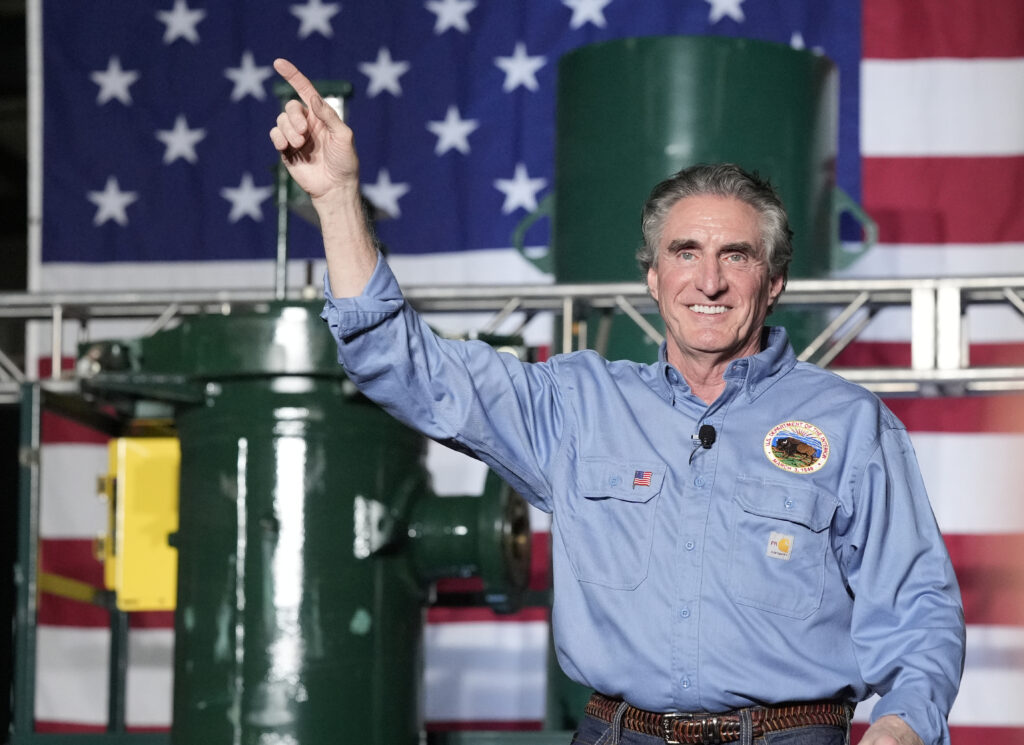When US President Donald Trump called for “energy dominance” on inauguration day, he quickly followed up with a few executive orders—one issued the same day that overturned the Biden administration’s liquefied natural gas ban and another on February 14 that established the National Energy Dominance Council. Chaired by Secretary of the Interior Doug Burgum and vice-chaired by Secretary of Energy Chris Wright, the council was created to advise the president on “strategies to achieve energy dominance by improving the processes for permitting, production, generation, distribution, regulation, and transportation across all forms of American energy.” But despite these positive steps, three months into the Trump administration, this early momentum is in danger of dissipating.
US energy producers are growing increasingly wary of Trump’s policies and are calling 2025 the year of “uncertainty.” They see geopolitical uncertainty, volatile oil prices, and erratic tariffs as reasons to exercise capital discipline, potentially shut in production, and forgo planning for future operations. One executive told the Dallas Federal Reserve that he has “never felt more uncertainty about our business in my entire forty-plus-year career.”
The National Energy Dominance Council must act quickly to restore stability to the energy industry. The council can take advantage of this juncture to craft reasonable, achievable energy strategies that aren’t driven by ideology or underpinned by untested technology. To ensure real progress toward energy security, the council should follow these seven principles.
1. Move quickly
Energy infrastructure is a long game. The council needs to figure out its plan in the next two months, because four years is considered short-term in energy development. For example, it can take a decade or more from the time a discovery well is drilled to bring a new onshore oilfield online, and it can take seven to nine years to build a new natural gas pipeline. The Trump administration is operating in a new paradigm for energy policy, in which there are no guarantees from one administration to the next. With the stroke of a pen, permitting processes can be suspended, funding can be eliminated, and lease auctions can be canceled. The council doesn’t have a year to come up with a policy—it needs a well-articulated strategy in place before this summer.
2. Communicate with industry
The energy industry needs to know what to expect over the next four years, and, if possible, beyond that. The council should publish and publicize a timeline laying out the administration’s plans for energy regulation, permitting, funding, and leasing. This would allow businesses to make concrete plans and allocate capital effectively. The best way to encourage industry participation in domestic energy growth is to provide a clear map of the administration’s goals and intentions. Otherwise, lack of trust will either keep businesses and financial institutions from investing in US projects or force them to gamble on the accuracy of information they’ve obtained from inside sources. Oil company executives are already facing tremendous uncertainty due to the Trump administration’s tariff policies. The council could help alleviate this by establishing open, direct communication channels with industry.
3. Establish regulatory stability
Streamlining and stabilizing permitting processes doesn’t mean eliminating or scaling back environmental reviews. It means that when a company applies for a permit from the federal government, it should have reasonable certainty that, if the application meets the guidelines set by the agency, then it will be approved in a timely manner. This process was disrupted during the Biden administration, first when it halted all auctions to lease federal land for drilling just after taking office in 2021, and then when permits to drill on land already leased were held up in a bureaucratic backlog. The Biden administration further delayed the process by agreeing to reevaluate National Environmental Policy Act reviews that had already been completed for a large portion of the land leased during the first Trump administration in five western states. This prolonged an already lengthy process for oil and gas development, disincentivizing companies from exploring new land. Streamlining and simplifying the permit-review process would help reestablish industry confidence and encourage investment in US energy production.
Regulatory stability also means issuing new regulations in a timely manner and adhering to the deadlines those regulations establish. In recent years, the White House has not met this benchmark. The Biden administration, for example, delayed finalizing new methane emissions rules to oil and gas producers and new vehicle emissions standards to car manufacturers and dealerships well past its established deadlines. Today, the Environmental Protection Agency under Trump is reconsidering the Biden administration’s tailpipe regulation, which would have forced car dealerships to sell increasing numbers of electric vehicles regardless of consumer demand. No replacement regulations have been proposed, so the vehicle industry has no idea what to expect. New regulations need to be set so businesses can prepare, and federal agencies need to stop delaying the process beyond established deadlines. Regulatory uncertainty is extremely problematic for the auto and energy industries. Even when standards are stricter than industry would like, business leaders still prefer regulatory certainty to ambiguity.
4. Prioritize legislation over executive action
It is much more difficult, onerous, and time-consuming to pass legislation through Congress than it is to implement policy through executive orders or through regulatory agencies. But cementing policies through legislation ensures their implementation long after the sitting president leaves office. The council should push for legislation to secure future lease offerings for oil and gas drilling and for wind and solar farms so that no future administration can cancel or delay them for political purposes. The market should determine whether companies wish to bid for the rights to drill or build on this land, not politics. Likewise, land that should be protected from any energy development should be protected by law, not just the whim of the executive.
5. Develop strategic reserves of certain critical minerals
The United States has known for nearly a decade that China controls a startlingly high percentage of the world’s critical-mineral resources and that it is actively working to expand that control. Many of these resources, such as battery-grade lithium and cobalt, are critical to energy storage. There is bipartisan agreement that the United States needs to diversify its critical-mineral sources, but policies encouraging domestic production have been slow to emerge. Trump’s March executive order on critical minerals calls for fast-tracking the permitting process for new mining operations in the United States, but any new hard-rock mining operation will take many years to come online. To help secure supplies of the materials the United States needs to maintain its energy infrastructure and military readiness, the Trump administration should establish a strategic reserve for key critical minerals. Such government-controlled reserves would act as a cushion that could be used to temporarily alleviate supply shortages.
This would be especially valuable if Trump expects to continue to employ tariffs as a foreign-policy tool. For example, in February, China banned the export of certain critical minerals to US and allied defense companies in retaliation for tariffs. US weapons manufacturers, which rely on Chinese supplies of the metal tungsten, are now scrambling to find other sources. With 90 percent of the world’s tungsten supply controlled by China, Russia, and North Korea, a US strategic tungsten reserve would help keep the market from experiencing severe dislocation.
Likewise, copper is necessary for electrical wiring, semiconductors, and military hardware. The United States should establish a strategic reserve of copper to stabilize US copper supplies. This would be especially useful if, for example, Canada were to impose retaliatory tariffs on copper exports to the United States. The United States imports over one quarter of its copper from Canada, and the mere threat of tariffs is already upending the global copper market as companies increase imports to create their own stockpiles. A strategic reserve that could be released to combat the impact of potential future Canadian tariffs would likely help prevent panic buying and combat price spikes.
6. Incentivize investment in long-term oil and gas production
Production from conventional oil resources in the United States has been on a downward trajectory since 1986. The major increase in production since 2011 has come from unconventional resources, such as hydraulic fracturing, or fracking. Generally, production from fracking wells can be brought online more quickly than production from conventional wells. However, production from fracked wells declines more rapidly than production from conventional wells.
There isn’t much the federal government can do to incentivize companies to invest in oil and gas production in the United States outside of offering land, tax incentives, favorable regulation, government stability, rule of law, infrastructure, and predictability. The National Energy Dominance Council should examine each of these areas and find ways to improve their implementation. For example, it could recommend to Congress and the president that they amend the 1970 National Environmental Policy Act to include specific requirements for environmental assessments and environmental impact statements so that groups can no longer bring lawsuits demanding that permits and lease sales be invalidated because a government agency did not include a particular energy-market forecast. Lawsuits play an important role in checking corporate power in the United States, but the recent rise in frivolous lawsuits and lawsuits based on technicalities just to stall production disincentivizes companies from investing in long-term projects in the United States because they increase uncertainty. Changing the law could reduce the number of wasteful lawsuits and allow operations to move forward with reasonable environmental assessments.
7. Modernize infrastructure
While energy production is a major component of energy security, it is useless without the infrastructure to transport and transmit energy to consumers safely. The federal government should support the development of new pipelines to safely deliver natural gas to consumers. It should also support modernizing and improving electricity transmission infrastructure, including building long-distance transmission lines so that communities can access the cheapest and most efficient sources of electricity available, when they need them. Grants to study the state of the United States’ electricity infrastructure and government-backed loans to fund upgrades and modernizations that will improve safety and reliability should be made available to state and local governments.
The National Energy Dominance Council has the unique opportunity to recommend policies that could restore stability to the US energy sector and help ensure the United States’ energy security into the next century, but it needs to act soon. The council’s policy agenda should remove barriers to energy production without jeopardizing environmental protections, resolve regulatory uncertainties, streamline regulatory and permitting processes, build new strategic reserves for critical minerals, and modernize electricity transmission and pipeline infrastructure. Its most urgent task is to offer a sense of assurance and stability to energy producers that have been buffeted by regulatory, market, and geopolitical uncertainty.
Ellen Wald is a nonresident senior fellow with the Atlantic Council Global Energy Center and the president of Transversal Consulting.
Further reading
Thu, Apr 3, 2025
Profitability and power: Fixing US critical minerals supply chains
EnergySource By
The global critical minerals race is well underway, and the American supply chain is behind. To regain momentum, the US must make this industry viable by creating a financial framework that attracts and retains capital.
Mon, Mar 31, 2025
The future of global energy policy is abundance
EnergySource By Charles Hendry
The United States and Europe are diverging on energy policy, with the United States prioritizing low costs and economic growth while the United Kingdom and the European Union focus on decarbonization. But reconciling these approaches is possible through the lens of energy abundance—each country must leverage its most plentiful resources to drive down costs, enhance security, and support sustainability without burdening consumers.
Wed, Dec 11, 2024
The United States needs a durable national energy strategy
EnergySource By
The United States lacks a comprehensive, long-term energy strategy that can persist through election cycles and aligns energy security with broader national interests. Congress should address this shortfall by mandating a “National Energy Strategy” that establishes a durable energy policy framework.
Image: April 3, 2025, Washington, Pennsylvania, USA: April 3, 2025: US Secretary of the Interior and Chair of the National Energy Dominance Council Doug Burgum during the Celebration of American Energy event in Washington PA by Range Resources and American Exploration and Production Council (AXPC). Brook Ward / Apparent Media Group. © AMG/AMG via ZUMA Press Wire.




